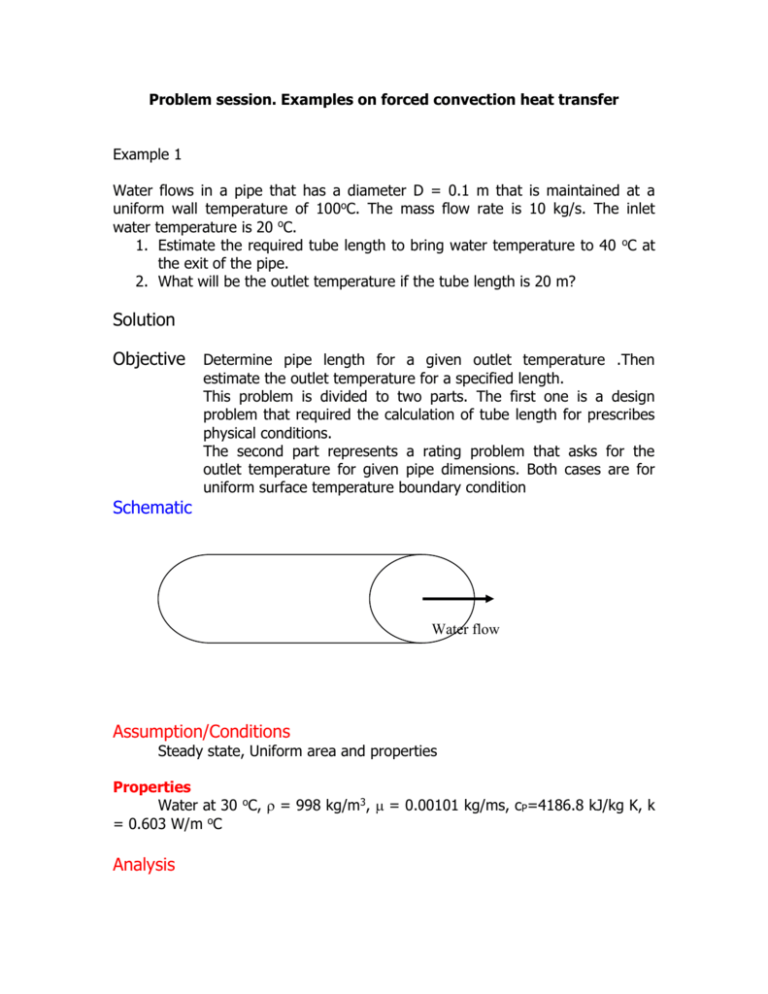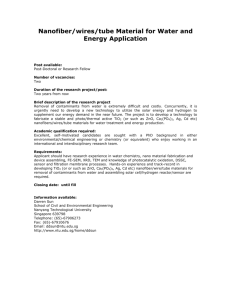doc
advertisement

Problem session. Examples on forced convection heat transfer Example 1 Water flows in a pipe that has a diameter D = 0.1 m that is maintained at a uniform wall temperature of 100oC. The mass flow rate is 10 kg/s. The inlet water temperature is 20 oC. 1. Estimate the required tube length to bring water temperature to 40 oC at the exit of the pipe. 2. What will be the outlet temperature if the tube length is 20 m? Solution Objective Determine pipe length for a given outlet temperature .Then estimate the outlet temperature for a specified length. This problem is divided to two parts. The first one is a design problem that required the calculation of tube length for prescribes physical conditions. The second part represents a rating problem that asks for the outlet temperature for given pipe dimensions. Both cases are for uniform surface temperature boundary condition Schematic Water flow Assumption/Conditions Steady state, Uniform area and properties Properties Water at 30 oC, = 998 kg/m3, = 0.00101 kg/ms, cP=4186.8 kJ/kg K, k = 0.603 W/m oC Analysis First we have to check whether the flow is laminar or turbulent. This is done through calculating the Reynolds number m 4m 4 *10 Ub 1.2758 m / s 2 A D 998 * 3.14159 * 0.12 U b D 998 * 1.2758 * 0.1 Re 126083.96 0.00101 Since Re > 10000, Flow is fully turbulent Then Prandtl number may be calculated as follows c 0.00101 * 4186.8 Pr P 7.01 k 0.603 Now, we may use the correlation for calculating Nusselt number for turbulent flow, assuming fully developed conditions; Nu=0.023 Re0.8 Pr0.333 = 529.9 = hD/k Then, h = 3195.26 W/m2 oC This part represents a design problem, thus, the log mean temperature difference method can be used: LMTD = (To T1 ) (To T2 ) 80 60 69.5o C (T T1 ) ln( 80 / 60) ln o (To T2 ) Therefore, the rate of heat transfer is calculated as: q = h As LMTD = m cP (T2 T1 ) =10*4186.8*(40-20) = 837360 W Therefore, As = 3.77 m2 = DL L = 12 m b. This part now represents a rating problem where the effectiveness method is recommended: m =10 kg/s L = 20 m h = 3195.26 W/m2 oC As = D L = 6.28 m2 (using the same correlation given above) NTU = h As = 0.48 m cP T2 T1 Then T2 = 50.5 oC To T1 The heat transfer can be evaluated as follows: 1 exp( NTU ) = 0.38 = cP (T2 T1 ) 10 4186.8 (50.5 20) 1271484 W qm Example 2: Air at 27 oC enters a 10-cm diameter tube of 10-m length with surface temperature at 100 oC. The mass flow rate is 0.06 kg/s. 1. 2. 3. 4. 5. 6. Calculate the Bulk stream velocity Ub. Calculate the Reynolds number Re. Is the flow laminar or turbulent? Show that Prandtl number Pr = 0.7071. Calculate the friction factor f and heat transfer coefficient h. Calculate the outlet temperature and the rate of heat transfer. Calculate the power required to overcome friction losses. Solution Objective This is a rating problem that asks for the outlet temperature and heat transfer rate for given pipe dimensions. Uniform surface temperature boundary condition is considered Schematic Air flow Assumption/Conditions Steady state, Uniform area and properties Properties Air properties at 27 oC are: = 1.18 kg/m3, cP =1 kJ/kg oC, = 1.57x10-5 m2/s, k = 0.0262 W/m oC. Analysis a. Bulk stream velocity: m 4m 4 * 0.06 Ub 6.474 m / s 2 A D 1.18 * 3.14159 * 0.12 b. Reynolds number: U D 6.474 * 0.1 Re b 41236.3 1.57 10 5 c. Prandtl number c c P 1.18 1.57 10 5 1000 Pr P 0.707 k k 0.0262 d. friction factor and heat transfer coefficient 2 f 1.58 ln Re 3.28 0.00548 Nu=0.023 Re0.8 Pr0.333 = 100.88 = hD/k Then, h = 13.21 W/m2 oC e. outlet temperature and rate of heat transfer Use the effectiveness method As DL 0.1 10 3.14157 m 2 1 exp( NTU ) where Ntu h As m cP T T T 27 1 exp( NTU ) 0.5 = 2 1 2 To T1 100 27 T2 = 63.5 oC 13.21 3.14157 0.692 0.06 1000 cP (T2 T1 ) 0.06 1000 (63.5 27) 2190 W qm f. Pumping power, neglecting entrance and exit losses; U b 4 Lf 1.18 6.474 4 10 0.00548 8.372 kPa 2 D 2 0.1 m P 0.06 8.372 W 0.42 W 1.18 P Example 3 Oil is heated in a tube that is maintained at a uniform wall temperature (Ts = 150 oC). The tube diameter is 5 cm and it is 25 m long. Oil flow rate is 0.5 kg/s and its inlet bulk stream temperature is 20 oC. Estimate the heat transfer rate and oil exit temperature. Solution Objective This is a rating problem that asks for the outlet temperature for given pipe dimensions. Boundary condition is uniform surface temperature. Schematic Water flow Assumption/Conditions Steady state, Uniform area and properties Properties Oil at 30 oC, = 852 kg/m3, = 0.032 kg/ms, cP=2131 J/kg K, k = 0.138 c P 0.032 2131 W/m oC, Pr = 494 k 0.138 Analysis a. The bulk stream velocity is calculated first as follows: m 4m 4 * 0.5 Ub 0.3 m / s 2 A D 852 3.14159 * 0.05 2 b. Reynolds number Re U b D 852 0.3 0.05 400 0.032 Laminar Flow Since the flow is laminar, we need to know whether it is developing or fully developed. The condition for hydrodynamically fully developed flow x x 0.05 Re Pr is: 0.05 Re and for thermally fully developed flow D D 0.05 * Re = 20 L/D = 20/0.05 = 400 0.05 * Re * Pr = 9880 This means that the flow is hydrodynamically fully developed, but thermally developing (thermal entry length) and hence, Nusselt number is given by the following relation: Re Pr L/ D Nu D 3.66 13.09 2/3 Re Pr 1 0.04 L/ D k h Nu 36.13W / m 2o C D Now, use the effectiveness method to estimate the heat transfer rate and oil exit temperature As DL 0.05 20 3.14159 m 2 36.13 3.14159 1 exp( NTU ) where Ntu h As 0.106 0.5 2131 mc 0.0668 P 1 exp( NTU ) 0.1= T2 T1 T2 20 To T1 150 20 T2 = 33 oC cP (T2 T1 ) 0.5 2131(33 20) 13851.5 W qm Example 4 Air enters a tube with a flow rate of 0.02 kg/s and temperature T1 = 20 oC .The tube diameter D = 0.05 m and it is maintained at constant heat flux (q”= 1000 W/m2) boundary conditions. Assume fully developed conditions apply for the whole pipe length (L = 3 m). 1. 2. 3. 4. 5. Estimate the bulk stream velocity. Calculate the heat transfer coefficient. Calculate the heat transfer rate. Calculate the exit bulk stream temperature. Estimate the surface temperature at the inlet and exit of the pipe. Solution Objective Exit bulk stream temperature and surface temperature at inlet and exit of the pipe that is maintained at UHF boundary conditions. (Dimensions are given). Schematic Air flow Assumption/Conditions Steady state, Uniform area and properties Properties Air at 300 K, = 1.16 kg/m3, = 1.846*10-5 kg/ms, cP=1007 J/kg K, k = 0.0263 W/m oC and Pr = 0.707 Analysis a. Bulk stream velocity: m 4m 4 * 0.05 Ub 8.78 m / s 2 A D 1.16 * 3.14159 * 0.05 2 b. Reynolds number: U b D 1.16 8.78 0.05 27589.16 1.846 10 5 Fully turbulent flow c. friction factor and heat transfer coefficient Re Nu=0.023 Re0.8 Pr0.333 = 73.14 = hD/k Then, h = 38.47 W/m2 oC d. rate of heat transfer As DL 0.05 3 0.47 m 2 q = q” * As = 1000 * 0.47 = 470 W e. outlet temperature cP (T2 T1 ) 0.02 1007 (T2 20) q 470 m T2 = 43.33 oC f. Surface temperature at x= 0 and x = L Apply Newton law of cooling q" hTs Tb q" Ts Tb h 1000 20 46 o C Therefore, Ts ,inlet 38.47 1000 Ts ,outlet 43.33 69.32 o C 38.47 Example 5 Wind flows across a steam pipe (D = 10 cm) that has an outside surface temperature of 127 oC. The wind temperature is 27 oC at a velocity of 10 m/s. Estimate the heat loss from the pipe per unit length. Solution Objective Heat transfer rate from a pipe exposed to cross flow of air. Schematic Air flow steam Air flow . Assumption/Conditions Steady state, Uniform area and properties Properties T T Air at Tm o 350 K , = 2.076*10-5 m2/s, k = 0.03 W/m oC and Pr 2 = 0.697, = 2.075*10-5 kg/ms = 2.286*10-5 kg/ms and ∞ = 1.846*10-5 kg/ms Analysis a. Reynolds number: U D Re 10 0.1 48169.56 2.076 10 5 Laminar flow b. Heat transfer coefficient Nu D (0.4 Re 0 .5 D 0.06 Re hD / k 139.6 Then, h = 41.88 W/m2 oC 2/3 D ) Pr o 0. 4 0.25 c. rate of heat transfer per unit length As DL 0.1 1 0.314159 m 2 q hAs To T 41.88 0.314159 (127 27) 1315.63 W






